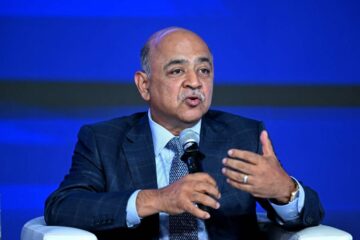If you’re nearing retirement – or already in it – your top financial priority may have shifted from growth to preservation. When market volatility threatens your hard-earned savings, buffered ETFs could offer a compelling solution.
These defined-outcome investments are designed to limit losses in exchange for capping gains, helping you stay invested through turbulent markets while safeguarding your portfolio against major declines.
💵💰Don’t miss the move: Subscribe to TheStreet’s free daily newsletter 💰💵
Buffered ETFs (also called buffer ETFs or defined-outcome ETFs) have seen explosive growth – from just over $5 billion in assets in 2020 to nearly $50 billion today, according to Morningstar. But despite their popularity, they remain widely misunderstood. Here’s what you need to know.
Buffered ETFs have seen assets under management explode higher alongside stock market volatility.
How buffered ETFs use options strategies
Buffered ETFs are built using options strategies. According to Erik Ogard, co-founder of BufferLABS, these funds typically buy deep in-the-money S&P 500 call options for market exposure. To generate income and define the range of outcomes:
They sell a call option to cap the upside return.They buy a near-the-money put to provide downside protection.They sell a deeper out-of-the-money put to help fund the protective leg.
This structure creates what Ogard calls a “collared put spread,” offering a known level of downside protection – commonly 10%, 20%, or even 50% – in exchange for a cap on how much you can gain over a fixed “outcome period” (usually 12 months).
Who should consider buffered ETFs
“Long-term investors who have the time horizon and staying power to ride out market volatility should not invest in buffered ETFs,” says Dan Kern, the chief investment officer at Nixon Peabody Trust Company.
These products, according to Kern, are specifically designed for investors with shorter time horizons and lower risk tolerance.
Related: Shark Tank’s Kevin O’Leary sends strong message on 401(k)s, recession
However, Kern notes that “a down market in the early years of retirement can significantly reduce the longevity of retirement savings, so buffered ETFs can be an appropriate investment for retirees or those nearing retirement.” They help narrow the range of potential outcomes, which is valuable for investors concerned about sequence-of-return risk.
Other situations where buffered ETFs might make sense include:
Retirees taking systematic withdrawals.Investors with low risk tolerance.Portfolios exposed to sequence-of-return risk; to the danger that retirees or others making regular withdrawals face when they need to take money out of their investment accounts during market downturns.
Why Retirees Might Consider Buffered ETFs
Built-in downside protection: Buffered ETFs offer what Ogard describes as “insurance against a meaningful, protracted market decline.”
Depending on the structure, he says investors might be protected from market losses between 5% and 20%, or even up to 50% in some cases. For retirees who can’t afford to recover from a deep drawdown, that kind of safety net is invaluable.
Appealing to conservative investors: Ogard makes a case for retirees and pre-retirees: “Maybe you don’t need equity market-like returns when you’re in retirement. You need some of them, but really, what you need is more protection.” For those drawing down retirement savings, buffered ETFs may help mitigate sequence-of-returns risk by softening the impact of downturns.
Real-world performance validation: Ogard highlights recent results to make his point. In 2022, when the S&P 500 fell nearly 19%, laddered buffered ETF strategies like those from First Trust and Innovator lost just 4–5%. In 2023, when the market bounced back by 24%, these same products returned 18–19%. “The proof of the pudding is in the eating,” says Ogard, who adds that these strategies outperformed hedge funds in that stretch, with daily liquidity and reasonable fees.
Emotional discipline and peace of mind: Retirees may also benefit from the psychological stability that buffered ETFs can provide.
“If the market went down 50%, can you take that kind of risk and can you recover from it?” Ogard asks. For many, the answer is no. Buffered ETFs can help investors remain invested without the emotional distress that often accompanies market crashes.
What risks exist for buffered ETFs
Complexity and terminology: “The primary downside is complexity,” says Ogard.
Buffered ETFs can be “squishy,” especially for do-it-yourself investors. Understanding technical terms like “remaining buffer” and “outcome period” is essential – but not easy. “I can’t imagine asking my 92-year-old mother to try to understand them – no chance,” he says.
Related: Scott Galloway sends strong message on Social Security, boomers
Higher fees: “Fees are higher than that of index ETFs, so investors should be aware of the cost of the buffered ETF,” says Kern. These higher fees are the price you pay for the options strategy that provides downside protection.
Timing considerations: “Investors should understand how much downside protection is offered by the ETF, the cap on potential upside, and the period of time remaining for the buffered outcome,” says Kern. “It typically will make sense to buy early in the outcome period and hold it until the end.”
Unpredictable interim performance: These funds are designed to deliver results at the end of the outcome period. But along the way, their value can behave unpredictably. “There is a payoff curve to the options package that doesn’t match during the interim period,” says Ogard. That mismatch can confuse or frustrate investors expecting linear results.
Vintage effect: Timing matters. “These instruments are kind of like wine years,” says Ogard. Market conditions at the time of issue determine the available caps and buffers. Two identical-looking funds launched months apart may have very different risk/reward profiles.
Limited upside: “You’re selling away some portion of the upside by selling a call,” says Ogard. That cap can mean missing out during strong bull markets – a tradeoff that may frustrate growth-focused investors.
Outcome period risk: If you buy or sell mid-cycle, you may not receive the full advertised protection or return. “There’s a lot of opportunity for a surprise bad experience,” Ogard says, especially for investors who don’t hold to the reset date.
Not ideal for frequent traders: Buffered ETFs are best used as long-term tools, not trading vehicles. “Proceed if you’re willing to buy them and put it in a drawer and ignore it until the reset period,” says Ogard. Active investors who check performance weekly may be misled by temporary fluctuations or discouraged by seeing one fund outperform another.
When and How to Use Buffered ETFs
As Kern suggests, investors should do their homework before investing in buffered ETFs, as many variations are available. Understanding the specific features of each product is essential to making an informed decision.
One smart approach is to use a bucket strategy: Place buffered ETFs in the short-term or income bucket while allocating traditional equities to longer-term growth buckets. This segmentation helps manage risk and maintain flexibility.
How much should you allocate?
The right mix depends on your age, wealth, and risk tolerance. But Ogard suggests some retirees may benefit from allocating “way more than even half of their equity allocation to buffered ETFs.” He encourages investors to ask: “Could you financially and psychologically withstand another 1987-style 22% drop in a day?”
Implementation tips
Ogard says laddered buffered ETFs offer automatic monthly resets for hands-off investors, reducing the need to time entries and exits. Popular options include:
First Trust’s BUFRInnovator’s laddered strategiesPacer’s actively managed buffered ETFs, which Ogard says handle “the hard lifting for you.”
For his part, Brian Regan, senior portfolio manager at Wealth Enhancement Group, uses buffered ETFs as a fixed income or equity alternative within diversified portfolios.
“They are relatively low cost compared to conventional alternatives,” says Regan. He emphasizes the importance of positioning: “Think about them in the context of a widely diversified portfolio,” he says
A Look at Some Buffered ETFs
iShares/BlackRock Buffer ETFs
The iShares Large Cap Moderate Buffer ETF (IVVM) seeks to track the share price return of the iShares Core S&P 500 ETF up to an approximate upside limit (cap), while providing downside protection against approximately the first 5% of losses over each calendar quarter.
The iShares Large Cap Deep Buffer ETF (IVVB) offers protection against approximately 5-20% of losses over each calendar quarter, also with a cap on upside potential.
BlackRock’s iShares Max Buffer ETFs provide up to 100% downside protection over a one-year period, with a corresponding cap on upside returns. For example, some of their funds offer full principal protection in exchange for capping maximum returns at around 8-9%.
Innovator Buffer ETFs
Innovator, which pioneered defined-outcome ETFs in August 2018, offers a range of buffer products, including its Equity Defined Protection ETF, which provides a 100% buffer against losses with a cap of 16.62% over a two-year outcome period.
Innovator offers various buffer ETF products, primarily focused on 12-month time horizons, including products like the Innovator US Equity Power Buffer ETF July ( (PJUL) ).
First Trust Buffer ETFs
First Trust also offers buffer ETF products, typically with 12-month time horizons and using options on third-party ETFs.
Pacer Swan SOS ETFs
Pacer offers several series of Swan SOS (Structured Outcome Strategies) ETFs that reset quarterly with different buffers and caps. These are organized into January, April, July, and October series, allowing investors to enter strategies at different times throughout the year.
You might also like:
Asset Allocation: Building a Portfolio for Your Financial Goals Beyond the S&P 500: A Guide to Concentrated, Diversified Equity Investing
Related: Veteran fund manager unveils eye-popping S&P 500 forecast


